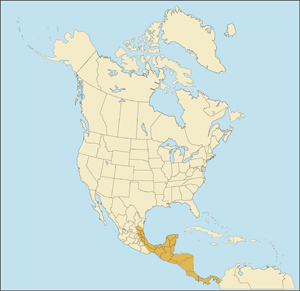 |
Mazama americana
Corzuëla roja (Sp), Roter Mazama (G), Daguet rouge (F). Local names include temazate and cabrito rojo (Mexico). Mazama is derived from mazame, a 16th century word for deer in Mexico.
DESCRIPTION Specimens in Campeche, Mexico, stand 18-20 inches (46-51 cm) at the shoulder, and weigh 22-30 pounds (10-14 kg), average 26 pounds (12 kg). Females are virtually the same size as males.
The red brocket is the smallest North American deer, notably smaller than the lighter-colored gray-brown brocket. It has a stout body with an arched back, slender legs, a short tail, ears of moderate size, and an elongated face. The coloration varies from reddish-brown to dark brown, but from mid-back to tail it is usually reddish . White areas include underside of jaw, throat, breast, groin area, a narrow stripe on back of front legs, inside of rear thighs, and underside and tip of tail. The ears are small, haired on the back, and dark-almost black-in color. The hairs on nape of neck are reversed. Fawns are spotted for the first several months. The skull is shorter than in the gray-brown brocket, especially that part of the skull behind the antlers, which is much shorter.
Typically, the antlers are short, simple spikes of 2-1/2 to 4-1/2 inches (64-114 mm), occasionally longer, that grow upward from a short, hairy pedicel at a slight forward angle to the line of the face. However, in an occasional specimen one or both antlers will have a very small brow tine; such tines are always non-typical in brocket deer. Antlers are grown and shed at irregular times, and may be retained for periods longer than one year.
BEHAVIOR Usually solitary, or a female with her young, the sexes coming together only briefly to mate. A single fawn, occasionally twins, is born after 225 days, gestation and remains with the mother through the first year. Females can breed at about one year. One captive lived almost 14 years.
Reported by different authorities as being diurnal, nocturnal or crepuscular. Relatively sedentary, with a small home range. Seldom seen and little known because of its extreme shyness and wariness. Often remains motionless when danger is sensed. Lacks endurance compared to other deer, and can be run down and killed by an ordinary dog. Excellent swimmer, easily crossing large rivers. Diet includes fallen fruits and seeds, grasses, shoots, vines, and crops where available.
HABITAT Humid tropical forest. Disappears when the forest is cut or burned too much.
DISTRIBUTION Mexico: Yucatán Peninsula, Chiapas, eastern Oaxaca, and the Gulf Coast north to southern Tamaulipas. Central America: Guatemala, Belize, El Salvador, Honduras, Nicaragua, Costa Rica, and Panama.
Also found in South America from Colombia southward to the northeastern edge of Argentina. Has the widest distribution of any species of brocket deer.
REMARKS A very difficult and challenging game animal. Hunted intensively by locals for its tender, delicious meat, yet continues to thrive in areas where whitetail deer have been completely exterminated.
TAXONOMIC NOTES Three subspecies are listed in North America: temama (southeastern Mexico to Belize), cerasina (Guatemala to Costa Rica) and reperticia (Panama, and extending into South America in western Colombia and Ecuador). We do not separate them. (Whitehead lists another 11 subspecies entirely in South America.)
Some biologists believe the red brockets of North America, or at least those of Mexico and Belize, should be recognized as a distinct species (Mazama temama), but this still awaits general acceptance.
|




